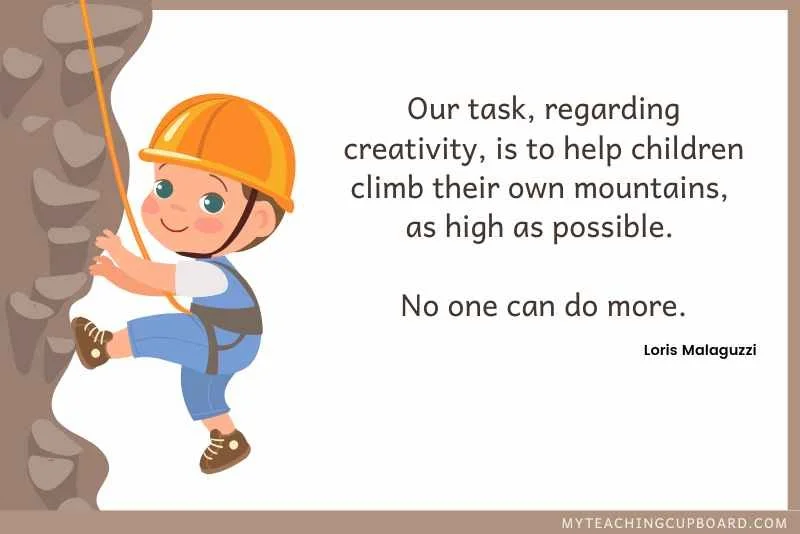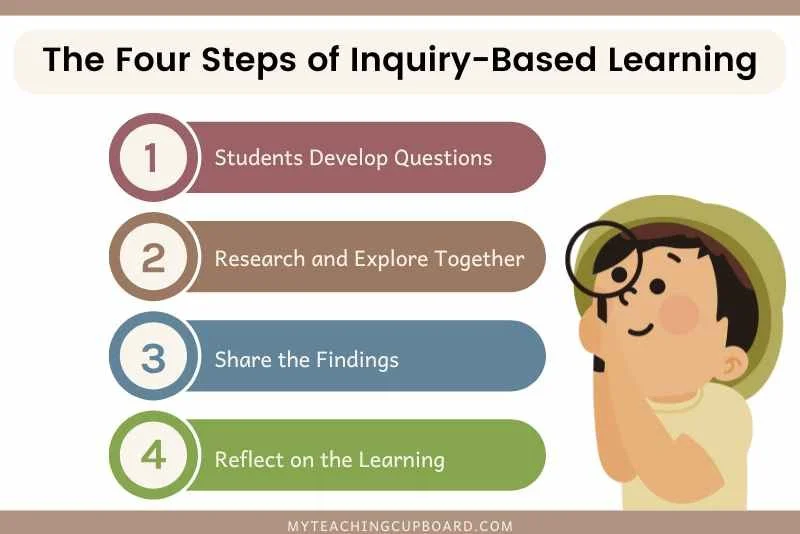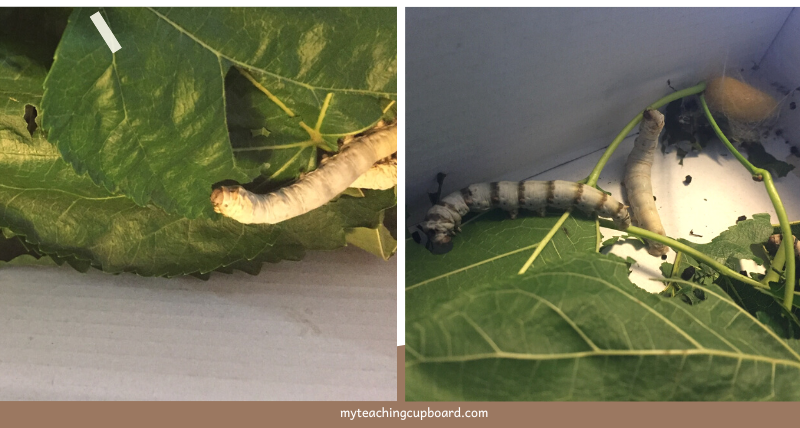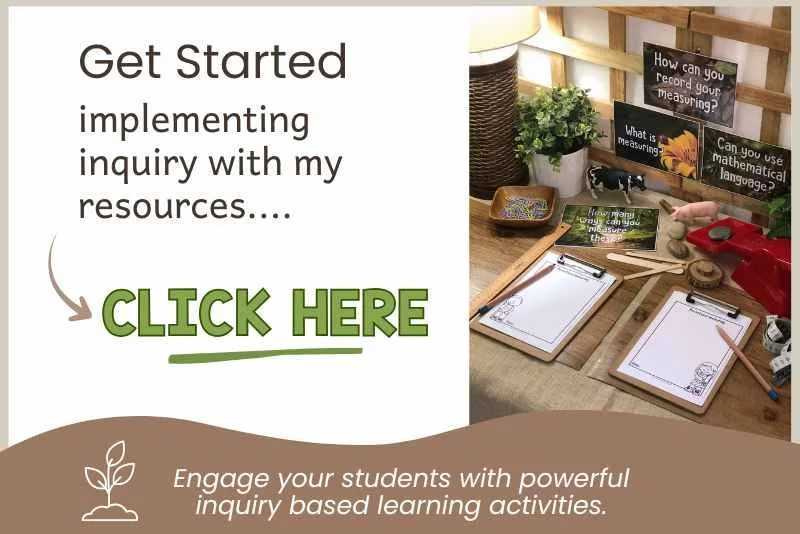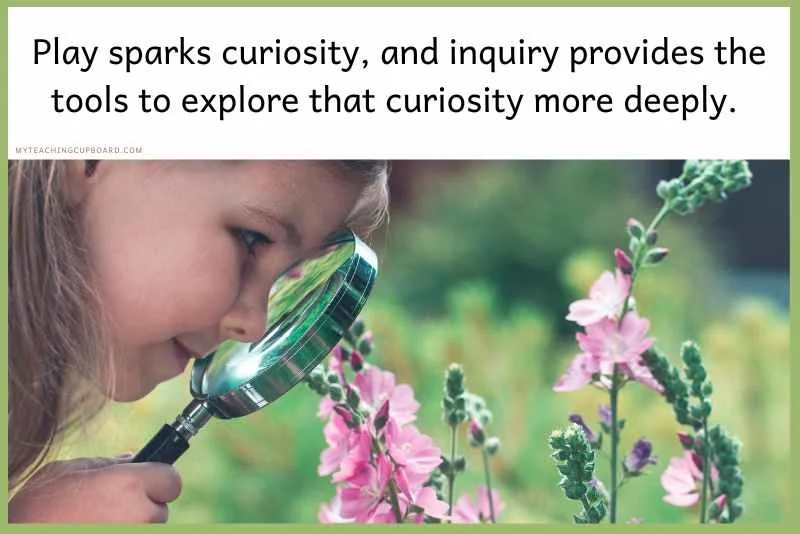What is Inquiry Based Learning in Early Childhood?
Discover how inquiry-based learning can transform your early childhood classroom by fostering critical thinking, problem-solving, and deeper student engagement. Learn how this inquiry-based approach complements a play-based pedagogy and create a more engaging learning environment.
Children are natural-born questioners. Have you ever had a child ask questions like, "What happens to butterflies when it rains?" or "Where does the sun go at night?" These simple questions could be the starting points of inquiry - deep exploration and wonder.
A child’s world is full of curiosity. So how do we, as early childhood educators, nurture this natural desire to know more? How do we channel their endless questions into meaningful learning experiences?
If you’re looking for a way to harness your students' natural curiosity into deeper, more thoughtful learning, this blog post is for you!
Are you curious? Do you have your own questions and find yourself wondering how to set up a classroom that encourages critical thinking while also meeting all those curriculum standards?
It can be quite challenging to balance curiosity and creativity with structured learning. Especially with the growing focus on academic outcomes in our early childhood education programs these days.
Inquiry-based learning could be the answer!
This approach gives educators the pedagogy they need to guide children in asking questions, investigating, and thinking critically about the world around them. By embracing inquiry-based learning, you can create a classroom environment that both engages students in the learning process and ensures they’re developing essential skills for future success.
In fact - I believe that understanding inquiry-based learning can completely transform your approach to teaching. It can help you cultivate more engaged, thoughtful, and curious students.
What is Inquiry-Based Learning?
Inquiry-based learning is a student-centred approach that encourages children to ask questions and explore real-world problems. An inquiry-based approach develops lifelong learning because it shows children how to use their critical thinking and problem-solving skills to deepen their learning.
In this educational approach students are encouraged to
ask questions
explore
and investigate
in order to construct their own understanding of the world.
In early childhood education, this means supporting and encouraging young learners to follow their natural curiosity.
It’s about guiding them through a process of discovery.
Unlike traditional teaching methods, inquiry-based instruction allows children to follow their own wonderings through a student inquiry process. It guides them to possible solutions for a central question or a particular problem.
This approach moves away from the traditional classroom pedagogy and gives students opportunities to actively engage with their learning. Instead of simply providing answers, inquiry educators prompt children to think critically, ask deeper questions, and engage in active exploration.
Loris Malaguzzi, the founder of the Reggio Emilia approach, believed in the power of children's curiosity and their ability to learn through questioning. He once said, "Our task, regarding creativity, is to help children climb their own mountains, as high as possible. No one can do more."
This aligns beautifully with inquiry-based learning because it suggests a questioning mindset and the idea of encouraging children to become active participants in their own learning journeys.
Inquiry-based learning is closely aligned with a play-based pedagogy because both approaches emphasise deeper thinking and exploration.
While play-based learning encourages open-ended play, inquiry-based learning adds a layer of structured questioning and investigation. It supports children to make connections, test their ideas, and find meaning in their experiences. Together, these approaches create a dynamic learning environment that promotes critical thinking, problem-solving, and lifelong curiosity.
By adopting this type of learning into your early years classroom, you can help your young children develop essential skills that will serve them throughout their entire educational journey.
This method goes way beyond traditional strategies of memorising facts. It encourages children to think deeply and engage in meaningful learning through inquiry.
The Four Steps of Inquiry-Based Learning
Inquiry-based learning follows a simple yet powerful process that encourages students to take an active role in their learning. In early childhood settings, this process can be broken down into four steps.
Each step in the process is designed to spark curiosity, exploration, and deeper understanding.
Let's take a closer look at how you can guide your students through these steps in a way that fits naturally into your play-based classroom:
1. Students Develop Questions They Are Interested in Answering
Inquiry begins with the child’s natural curiosity. In an early childhood classroom, this might look like a child asking, "Why do leaves change colour in Autumn?" or "How do birds build their nests?"
These questions are gold! The spark that ignites the learning process. Encouraging children to ask their own questions helps them take ownership of their learning, making it more meaningful and engaging.
To facilitate this first step, you can use open-ended questions as prompts to get children thinking more deeply about the world around them and real-world problems.
For example, during a nature walk, you might ask, "What do you think will happen to the flowers now that it’s getting colder?" This helps steer their curiosity toward inquiry-based exploration.
You can read more about open-ended questions and the tremendous power they have in the classroom here in my blog post: Open-Ended Questions to Promote Higher Order Thinking. In this blog post, you can also discover practical tips, sample questions, and strategies to use them for boosting critical thinking and student confidence in your classroom.
2. Research and Explore the Topic Together
Once children have posed their questions, the next step is to investigate.
Please don’t head to the library to read through stacks of books! Use the kids’ questions as a springboard to hands-on explorations. For example, if a child is curious about how plants grow, you might set up a learning invitation where they can plant seeds or care for a small garden. This way they can observe the growth process firsthand.
This is where inquiry-based learning aligns so well with play-based pedagogy. With a little creative thinking, you can support your children to explore their questions through play.
The way I do this is to think about each investigation area individually and brainstorm possible provocations that could lead children to explore their questions. I also focus on providing opportunities for hands-on exploration and collaborative learning.
3. Present What They’ve Learned and Develop Understanding
After plenty of investigating and exploring, children should be given the opportunity to share their findings.
This could be as simple as a discussion where they explain what they’ve learned, or it might take the form of a creative project, like drawing a picture, building a model, or making a presentation to the class. The idea is that children document their learning and their thoughts.
Documentation is often left to the teacher but we have enough to do! Hand it over to the children!
For example, in my classroom, a group of children were asking lots of questions about insects so I set up some suitable resources at our Science table.
After the little biologists explored different types of insects, they created a poster together showing the life cycle of a butterfly. This poster was presented to the class at reflection time and then put on display above the insect provocation.
Creating the poster and presenting it to the class helped the children process the information they had gathered and make sense of it in a way that was meaningful to them.
There was a roll-on effect too! More children became interested in insects and others started creating posters around topics they were interested in.
In a play-based learning classroom focused on inquiry, the learning snowballs. It's so exciting for the children and the educators!
4. Reflect on the Learning Process
The final step is reflection. This is where you encourage your students to think about what they’ve learned and the process they went through to get there. You might ask them questions like, "What did you find interesting?" or "What was challenging about this project?"
Reflection helps students develop metacognitive skills. It encourages them to think about their thinking and identify what worked well and what didn’t.
For example, after the poster-making frenzy I mentioned earlier, I gathered the whole class for a reflection session. We talked about what the children enjoyed, what surprised them, and how they might make a poster differently next time.
By guiding your students through these four steps
developing questions
researching
presenting
and reflecting
you will not only teach a deeper understanding of the subject matter but also help your students to develop important critical thinking and problem-solving skills.
Each step in the inquiry-based learning approach helps children develop essential skills
As students explore different ways to solve problems, they strengthen their communication skills and critical-thinking abilities. As students become more interested and excited about their discoveries, each step in the inquiry process also encourages intrinsic motivation.
Types of Inquiry-Based Learning
Inquiry-based learning comes in various forms, each offering a different level of structure and guidance for students.
In early childhood education, there's no best way to use this method of teaching. The type of inquiry you choose is more related to how well the approach fits into your play-based pedagogy.
The three main types of inquiry-based teaching are Structured Inquiry, Guided Inquiry, and Open Inquiry.
Structured Inquiry
In structured inquiry, the teacher provides a clear question and a step-by-step process for students to follow as they investigate the answer.
While the teacher directs the inquiry, students are still engaged in critical thinking and exploration. This problem-based learning method is particularly effective for younger children who may need more support in learning how to ask questions and conduct purposeful investigations.
Here’s an example: In a kindergarten classroom, the teacher might ask, “What happens to ice when it gets warm?” The children are given ice cubes and various materials like paper towels and containers so they can explore the melting process through teacher-guided steps. Though the process is structured, the students still experience hands-on learning and make observations about melting ice.
Structured inquiry is useful for early childhood educators who are introducing inquiry for the first time because it allows for a controlled environment while still encouraging students to think critically.
Guided Inquiry
In the guided inquiry approach, the teacher provides the main question or problem, but the students have more freedom to decide how they will investigate and find the answer.
This type of inquiry gives students a higher level of autonomy while still offering support from the teacher.
Guided inquiry allows children to take a more active role in their learning so it fits well with early childhood education where hands-on learning is a priority and independence is encouraged.
Here’s an example: In a first-grade classroom, the teacher might ask, “How do plants grow?” The students could be provided with a variety of materials like seeds, soil, and water, but they would be responsible for deciding how they will set up their experiment. One group might choose to plant seeds in different types of soil, while another group might experiment with different amounts of sunlight or water.
Guided inquiry strikes a balance between providing structure and encouraging independent thought.
It’s ideal for early childhood settings where students are developing their ability to think critically - but where they still need guidance from the teacher.
To support guided inquiry in your classroom, you can use my STEAM Prompt Cards, They are designed specifically to encourage creative and critical thinking in Science, Technology, Engineering, Art, and Math. I love using these prompts to help guide my students through scientific inquiries that challenge them to think deeply and explore various concepts in hands-on, collaborative ways.
Whether you use them with the whole class or in small groups, the cards will help you design and set up purposeful learning provocations in your investigation areas.
I will often display a prompt on a large screen for the entire class, but I also add them to investigation areas and encourage students to work with a friend to complete the challenges.
If you have specific curriculum goals, you can offer targeted materials for building, or simply let students choose from your classroom resources. My prompts are flexible enough to fit your teaching style and available resources.
They make a perfect addition to any inquiry-based or play-based learning environment!
Open Inquiry
Open inquiry offers the most freedom for students.
In this form of inquiry, children develop their own questions, design their investigations, and decide how they will present their findings. The teacher's role is to facilitate and provide support as needed. The learning process is largely student-led.
This type of inquiry fosters creativity, independence, and problem-solving skills.
Here’s an example: In a preschool classroom, a group of children might become fascinated with the insects they find outside during recess. They might decide to explore the question, “Why do ants always walk in a line?” The teacher helps them gather materials like magnifying glasses, paper and ipads for observations and documentation. But the children decide how to observe the ants, what to document, and how to share their findings with the rest of the class.
Open inquiry can be highly engaging in a play-based learning environment because it gives children the opportunity to follow their interests and lead their learning.
However, it sometimes works best for older children or those who are familiar with the inquiry process, as it requires a high level of independence.
Each type of inquiry—structured, guided, and open—has its place in early childhood education, and the best choice depends on your students’ needs and the level of support they require.
For younger children or those new to inquiry-based learning, structured and guided inquiries offer a balance of support and autonomy. As students grow more confident in their ability to ask questions and explore, open inquiry can provide a rich, child-led learning experience that taps into their natural curiosity and creativity.
Benefits of Inquiry-Based Learning in Early Childhood
Inquiry-based learning offers a range of benefits that include helping children develop critical skills they’ll carry with them throughout their education and beyond.
By giving your young learners opportunities to explore and investigate, inquiry-based learning can build a foundation for deeper understanding and a lifelong love of learning.
Fostering Critical Thinking, Problem-Solving, and Collaboration
One of the greatest strengths of inquiry-based learning is its ability to develop critical thinking in young children.
When students are given the opportunity to ask their own questions and explore possible answers, they naturally develop the ability to think critically about problems. Rather than simply accepting facts, they learn to analyse, evaluate, and synthesise information. This lays the groundwork for higher-order thinking.
In addition to critical thinking, inquiry-based learning encourages problem-solving.
As children explore their questions, they inevitably encounter challenges or puzzles that require creative solutions. For example, when investigating how plants grow, a child may realise that their seeds aren’t sprouting. This challenge invites problem-solving as they consider whether the plants might need more water, sunlight, or a different type of soil.
Collaboration is another key benefit.
Inquiry-based learning often involves working with peers. Children will discuss their ideas, share materials, and solve problems together. This helps develop social skills like communication, teamwork, and compromise – all essential for both academic and personal success.
Alignment with STEM Education
Inquiry-based learning aligns perfectly with the goals of STEM education. STEM involves Science, Technology, Engineering, and Math. In fact, inquiry is at the heart of STEM learning where curiosity, questioning, and experimentation are key components.
Through inquiry, children learn to approach problems like real-life scientists, engineers, and mathematicians. They will have learning opportunities involving hands-on explorations that can prepare them for more formal STEM learning in the later years of their schooling.
A study from the Sydney University’s inquiry-based learning project found that early engagement in inquiry-based STEM activities can foster a positive attitude towards these subjects and even lead to better performance and increased interest in STEM fields later in life.
Students engaged in inquiry-based learning develop stronger critical thinking and problem-solving skills when compared with those in more traditional classrooms.
There’s definitely long-term value in incorporating inquiry into early childhood education.
Deeper Understanding of Topics
Inquiry-based learning encourages students to dig deep into topics rather than skimming the surface of knowledge.
When children are involved in developing their own questions and seeking out answers, they form a more personal connection to the material. This leads to a deeper understanding of the subject matter because they are learning through experience and reflection rather than memorisation.
For example, a child investigating the life cycle of a butterfly could spend days observing caterpillars and documenting their growth. This hands-on approach allows the child to understand the process of metamorphosis far better than if they had simply been told about it in a lesson.
This depth of knowledge also enhances retention. When children engage deeply with topics, they are more likely to remember what they’ve learned and apply that knowledge to new situations. This creates a solid foundation for future learning because it helps children build on their previous experiences and connect new ideas to existing prior knowledge.
Increased Student Engagement
Inquiry-based learning naturally boosts student engagement because it supports children to explore their personal interests and take ownership of their learning. Whenever students are actively involved in asking questions and investigating solutions, they are more engaged and motivated to learn.
Classroom Success Stories
The benefits of inquiry-based learning can be seen in countless classrooms. Here’s just one example that comes to mind from my own teaching experience:
One day, a child brought in a board game from home, and his friends were soon playing it with excitement during investigation time. Curious about what made the game so enjoyable, I initiated a guided inquiry process with the group.
We began by discussing the key elements of the game: “It’s about dragons, which we love!” and “There are lots of surprises, like going back to the start or moving forward three spaces!”
Their answers gave us insight into what makes a board game fun. We turned this into a data collection opportunity, covering our math curriculum’s focus on data collection and statistics. The children gathered data from their classmates, asking what they liked most about their favourite board game. We then used this information to guide the design of their own original board game.
Next, we reviewed our math learning intentions together, making sure the children understood the skills and learning intentions we were focusing on in class, such as counting, and addition and subtraction with 2-digit numbers. With this in mind, they set about creating a board game that would not only be fun but would also help them practice these math skills.
Jumping on their infectious enthusiasm, I set up a board game-making station at our makerspace and the group eagerly took on the challenge of designing the best board game ever! Their final creation was impressive. They agreed to add it to one of our math group rotations for the following week.
Much like the butterfly life cycle project I mentioned earlier, their board game sparked a snowball effect in the classroom.
Before long, more children were designing their own games based on topics they loved.
We had board games about fairies, hot-rod cars, Minecraft, and Barbies! Each game not only encouraged problem-solving and creativity but also reinforced important math concepts through play.
This inquiry-based project provided a rich learning experience, blending statistics, guided inquiry, and creative expression and design. It engaged the children deeply, both in the design and in the review of their math learning. It created a meaningful connection for my students between play and academic skills.
The inquiry process transformed the classroom and turned it into a space of discovery, creativity, and collaboration. Not only did the children reinforce math objectives, but they also developed critical thinking, problem-solving, and social skills in the process.
This real-life example highlights the power of inquiry-based learning to create a dynamic, engaging classroom environment that fosters both academic and social growth.
Inquiry-based learning offers a wealth of benefits for early childhood education, from developing critical thinking and problem-solving skills to promoting collaboration and deeper understanding. By aligning with STEM education, it prepares students for future learning while also making the classroom a more engaging and exciting place for exploration.
Research and real-life examples show the effectiveness of this approach. It is such a valuable tool for any early childhood educator looking to create meaningful, lasting learning experiences.
More Examples of Inquiry-Based Learning in Early Childhood Classrooms
Inquiry-based learning can be integrated into various subjects like science, math, and literacy. By encouraging your students to ask questions and explore topics that interest them, you can foster a deeper understanding of the subject matter while also meeting those curriculum goals.
Here are a few concrete examples of how to implement inquiry-based learning in different subjects:
Science: Exploring the Properties of Materials
In a science-focused inquiry, children might explore the properties of different materials like wood, metal, and plastic.
You could start by posing a question like, “Which materials are best for building a strong bridge?” Provide the children with various materials and allow them to experiment with building bridges, testing which materials hold up under weight and which don’t.
During the process, encourage them to make observations, ask questions about why certain materials are stronger or weaker, and predict what might happen with different combinations. This hands-on exploration leads to a deeper understanding of material properties, as well as developing problem-solving and critical thinking skills.
You can take this even further by documenting their findings in a class book or chart so you’ll be integrating literacy into the inquiry process as well.
Math: Investigating Patterns in the Environment
Math inquiries can be just as engaging. When investigating patterns in their environment, for example, start with a question like, “What patterns can we find in the playground?”
Children can explore and document the shapes, colours, and arrangements they see around them. Guide them to see the repeating lines in the fence or the way leaves are arranged on a tree.
After gathering examples, invite the children to create their own patterns using loose parts, blocks, or art materials. This learning provocation not only reinforces concepts like sequencing and spatial awareness but also promotes critical thinking as children identify and replicate patterns in different contexts.
Once they’ve created their patterns, have them present their findings to the class, discussing what they discovered and how their patterns compare to those found in the playground.
Literacy: Gathering Research and Information
Inquiry-based learning can also play a significant role in literacy development. For example, in a literacy inquiry, children could investigate how different books tell stories. You might ask, “What makes a story exciting?” and have the children explore various books to see how authors use words, pictures, and characters to create engaging narratives.
After reading and comparing books, the children could create their own stories, either by writing, drawing, or acting them out. This process not only develops early literacy skills but also helps children understand the structure and elements of storytelling and narratives.
Another way to integrate inquiry into literacy is through research projects. Children can choose a topic they are interested in and gather information from books, videos, and even guest speakers. They can then create information reports or posters to share their new knowledge with the class.
Combining Subjects: A Nature Walk Inquiry
Inquiry-based learning doesn’t have to be limited to a single subject. A nature walk, for example, can integrate science, math, and literacy.
Start by asking, “What changes do we see in nature during different seasons?” As children explore the outdoors, they can observe changes in the environment, such as leaves changing colour or new plants sprouting.
Back in the classroom, they can document their findings in journals (literacy), sort and count the leaves or seeds they’ve collected (math), and hypothesise why these changes occur (science). This type of interdisciplinary inquiry engages children in holistic learning and encourages them to connect their experiences across different subjects.
These examples show just how versatile and powerful inquiry-based learning can be in early childhood classrooms.
By creating opportunities for exploration in science, math, literacy, and other curriculum subjects, you can foster critical thinking, creativity, and a deeper understanding of the curriculum.
To support your inquiry-based learning activities, you should check out my Investigations Resources.
There are heaps of materials covering a range of play-based learning opportunities and they’re all designed to help you implement inquiry in your classroom.
5 Strategies for Implementing Inquiry-Based Learning
Implementing inquiry-based learning in your classroom doesn't have to be overwhelming. With a few simple strategies, you can create an engaging and thought-provoking environment that encourages children to ask questions, explore, and discover.
Here are 5 practical tips for introducing inquiry-based learning:
1. Start with Small Inquiries
If you’re new to inquiry-based learning, it’s best to start small. Choose an easy topic or question to explore with your students. Choose something you have a bit of knowledge about. A good one for Science might be “What do plants need to grow?”
This way, you can get a feel for guiding the inquiry process without feeling overwhelmed. As you and your students become more comfortable with the approach, you can gradually expand the scope of your inquiries.
2. Create Provocations and Prompts That Spark Questions
A great way to spark inquiry in young children is through provocations. Learning provocations are simple setups or displays that encourage curiosity and questioning.
You can read more about them and discover my 3 easy steps to setting up the perfect learning provocation here in this blog post: 3 Steps to Setting Up a Learning Provocation
Provocations can be simple or complex. For example, simply placing a magnifying glass in a learning area can lead to numerous questions like “Why do the blocks have those marks?” or “What is fabric made from?”
Provocations are the secret sauce in a play-based classroom. They provide the starting point for deeper exploration and help guide children toward meaningful inquiry.
3. Provide the Right Materials for Exploration
Inquiry-based learning thrives on hands-on exploration and offering the right materials.
Providing open-ended materials, such as loose parts, nature items, or building materials, encourages children to investigate and test their ideas. These types of materials give children the opportunity to explore topics on their own terms and at their own pace.
The key is to offer materials that inspire children to experiment, create, and problem-solve while at the same time keeping the inquiry open-ended so they can follow their own questions.
4. Use Questioning Techniques to Guide Thinking
Asking the right questions can take a child’s inquiry to the next level. By using open-ended questions, you encourage higher-order thinking, helping children to think critically about what they are investigating. These types of questions don’t have a right or wrong answer, which allows children to explore different possibilities and ideas.
I recommend using my Open-Ended Question Prompts to guide your questioning during inquiry or investigations.
These beautifully designed open question prompts are a great tool for encouraging critical thinking in your classroom. Each card can be printed on A4 paper, and you can even tile them for smaller sizes.
I place them around the room or include them in provocations to spark thoughtful discussions with the children. They are such a help in reminding me to invite children to share their thinking and view of the world. They really help to enrich both academic and social learning.
5. Addressing Common Challenges
One challenge some teachers face with inquiry-based learning is finding the time to fit it into an already-packed curriculum. To address this, remember that inquiry-based learning can be integrated into existing subjects.
I have already provided examples of how to do this. Math inquiries can involve exploring patterns or gathering data, and literacy inquiries can focus on researching a favourite topic. By linking inquiry to your curriculum goals, you can ensure that children are both engaged and meeting academic standards.
Another challenge is balancing open-ended exploration with the need to meet our never-ending curriculum requirements.
This can be achieved by guiding the inquiry toward your curriculum learning objectives. For instance, if you’re focusing on measurement in math, you might pose an inquiry question like “How tall can we build a tower before it falls?” This question invites exploration while still aligning with curriculum goals.
Finally, time management can be a concern.
To manage this, start with shorter, more focused inquiries and build up to longer projects as you and your students become more comfortable with the process. By beginning small, you can incorporate inquiry-based learning without feeling like you need to overhaul your entire teaching approach.
These strategies will help you implement inquiry-based learning in a practical and manageable way.
It is worth it.
Inquiry will enhance your students' critical thinking, problem-solving, and collaboration skills.
It doesn’t have to be complicated. Just remember central to this approach is providing an opportunity for children to ask questions, explore, and reflect on their learning.
And with tools like provocations, open-ended materials, and questioning prompts, you’ll be well on your way to fostering a classroom full of curious and engaged learners.
Inquiry-Based Learning vs Play-Based Learning
Inquiry-based learning and play-based learning are both powerful approaches that encourage children to explore, think critically, and engage with the world around them.
While they share many similarities, they also have distinct features that make them unique.
Understanding how these two methods complement each other can help you create a balanced, dynamic classroom where learning feels natural and engaging.
Similarities Between Inquiry-Based Learning and Play-Based Learning
At their core, both inquiry-based learning and play-based learning are child-centred approaches. They emphasise the importance of giving children autonomy over their learning, allowing them to follow their curiosity, ask questions, and explore concepts in ways that make sense to them.
In both approaches, the role of the teacher is to act as a facilitator rather than a traditional instructor. Instead of delivering information directly, you guide children’s learning through thoughtful provocations, materials, and questions. This helps children build essential skills like problem-solving, critical thinking, and collaboration and they do it all while having fun and staying engaged.
Another key similarity is that both methods value hands-on, experiential learning. Whether children are investigating how things work through inquiry or exploring materials through play, they are learning by doing. This active engagement leads to a deeper understanding of concepts and helps children retain what they have learned.
Differences Between Inquiry-Based Learning and Play-Based Learning
While both approaches are child-centered, traditionally, inquiry-based learning is typically more structured than open-play-based learning. In inquiry-based learning, there is often a guiding question or problem that directs the exploration.
The teacher plays a more active role in guiding students toward specific learning goals, using questioning techniques and structured steps like developing questions, researching, presenting, and reflecting.
In contrast, unstructured play-based learning is more open-ended. Children are free to engage in play without a predetermined outcome, exploring materials and ideas in a way that is entirely self-directed. Play-based learning gives children the freedom to follow their interests without the constraints of a specific question or learning goal.
How Inquiry-Based Learning Complements a Play-Based Pedagogy
Although inquiry-based learning has more structure than play-based learning, the two approaches work beautifully together.
Inquiry-based learning can be seen as a natural extension of play. When children play, they naturally ask questions and experiment with ideas. For example, a child building a tower might wonder, “How tall can I make this before it falls?” This is where inquiry-based learning can step in to deepen their thinking.
By introducing thoughtful provocations or guiding questions during play, you can lead children from open-ended exploration to a more focused inquiry. This allows them to think critically about their play, engage in problem-solving, and make meaningful connections between their ideas, the curriculum and real-world concepts.
For example, in a play-based setting, children might engage in water play, exploring how objects sink or float. By asking an open-ended question like “What makes some objects float and others sink?” you can guide them into an inquiry, prompting them to test different objects, record their observations, and draw conclusions. This simple shift moves play into inquiry while still maintaining the child’s natural curiosity and engagement.
Inquiry as a Natural Extension of Play
In many ways, inquiry-based learning is a continuation of play.
Play sparks curiosity, and inquiry provides the tools to explore that curiosity more deeply.
Where play encourages children to experiment and explore in an open-ended way, inquiry helps them focus that exploration into meaningful learning experiences. It’s through questions and intentionally designed investigations that children can begin to develop a more sophisticated understanding of the world around them.
I like to blend these two approaches. You can too. You can create a classroom environment where play leads to deeper thinking and inquiry emerges naturally from children’s interests.
Play provides the freedom for children to explore, while inquiry offers the structure that helps them reflect on and expand their learning. Together, they create a balanced, engaging pedagogy that supports the development of critical thinking, problem-solving, and creativity.
Empower Your Students with Inquiry-Based Learning
Inquiry-based learning encourages children to ask questions, investigate, and think critically, creating a learning environment that fosters deeper understanding and meaningful exploration.
When combined with a play-based pedagogy, inquiry-based learning becomes a powerful tool for engaging students in hands-on, curiosity-driven learning. Whether through science, math, or literacy, inquiry helps children develop essential skills like critical thinking, problem-solving, and collaboration. On top of all this lies the engaging factor of keeping learning interesting and fun!
For us early childhood educators, looking to enrich our classrooms, inquiry-based learning provides endless opportunities to inspire and challenge our young students.
Believe me, I know from first-hand experience, by implementing inquiry, you will transform your classroom into a space where children are empowered to explore their interests and deepen their knowledge.
If you’re interested in more ideas on how to implement both play-based and inquiry-based learning in your classroom, I invite you to subscribe to my email newsletter for practical tips, creative provocation ideas, and engaging curriculum-aligned classroom resources.
Speaking of resources, don’t forget to check out my collection of Investigations Resources for ready-to-use materials that support play-based and inquiry learning.


